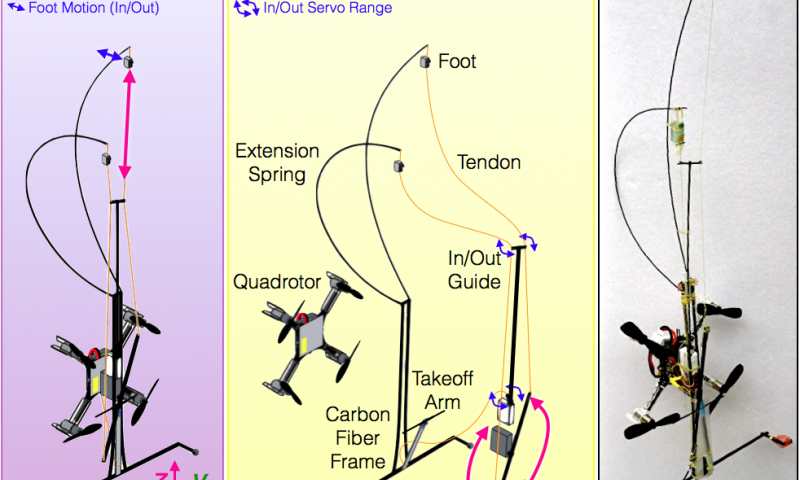SCAMP robots fly, perch and climb
Roboticists are as focused on small robots that can function and go where the big robots cannot. It's all about scale at the Biomimetics and Dexterous Manipulation Laboratory at Stanford. They are working on robots that live at the boundary of airborne and surface locomotion. Smaller robots are robust in dealing with impacts, more capable of rapid orientation changes, and can achieve higher adhesive forces relative to their size.
Perching is more achievable as size decreases. "Fundamental scaling laws tend to increase the ratio of surface area to volume as size decreases, meaning that smaller robots (even primarily terrestrial ones) can interact meaningfully with the air."
And on that note, they released a new video this month to introduce their SCAMP—the acronym tells it all. This is the Stanford Climbing and Aerial Maneuvering Platform.
It's capable of flying, perching, climbing, recovering from failure, and taking off—using only onboard sensing and computations—they can go where Big Dog and super-sized Atlas can't.
On the lab website they talked about SCAMP, the new member of their family of bio inspired robots, calling the result "a robot that's part woodpecker, part Daddy long-legs, and part hummingbird."
Carbon fiber and Spectra (a strong but light fiber) were used as materials for legs as long and weight-efficient as those of climbing insects.
With all that was going for these robots, one limitation would have to be addressed: Most quadrotors of this nature only have a few minutes of battery to sustain flight time.
The researchers recognised, in scenarios where there is rubble from earthquakes, clean vertical spaces available for perching—they could stay around longer. Applications: Measuring aftershocks; setting up a temporary communications network.

Morgan Pope is lead author on a paper about SCAMP, which is in review for IEEE Transactions on Robotics ("Robust Perching and Climbing Using Microspines on Vertical Outdoor Surfaces," by Morgan T. Pope, Christopher W. Kimes, Hao Jiang, Elliot W. Hawkes, Matt A. Estrada, Capella F. Kerst, William R. T. Roderick, Amy K. Han, David L. Christensen, and Mark R. Cutkosky).
Pope singled out its contributions: "SCAMP is the first robot to combine flying, perching with passive attachment technology, and climbing. It can also recover from climbing failures, as well as take off when it's ready to fly again."
The lab website said that to perch, "SCAMP flies tail-first into the wall. It detects the acceleration spike on impact and turns its rotors up to maximum. The tail acts as a pivot, and SCAMP attaches to the wall aerodynamically while its feet find good places to grip."
Pope recently discussed their work in IEEE Spectrum, and talked about how perching allows the machines to be around longer but poses some challenges for the team, too. "Perching can be tricky, because the odds of your drone landing in just the right place are low. Adding the ability to climb allows your drone to reposition itself more accurately, with the added bonus that it works if it's too windy for flight."
SCAMP climbs by alternating loads between its two feet. Pope detailed its climbing mechanism, using "one high torque-density servo to drive long steps up the wall, and one even smaller servo to actuate motion towards and away from the wall.
These two servos, combined with the carbon fiber frame and spiny feet, weigh only 11 grams. In effect, we've taken our 9-gram micro glass climber, modified it for speed instead of load capability, given it an extra servo to handle two-dimensional surface profiles, outfitted it with microspines, and strapped it to a tiny quadrotor."
The team will push on: "There are many things to do with SCAMP that we haven't had time to implement yet. For example, we can tune SCAMP's gait using the two servos, to compensate for surface roughness and slipperiness," Pope said.





